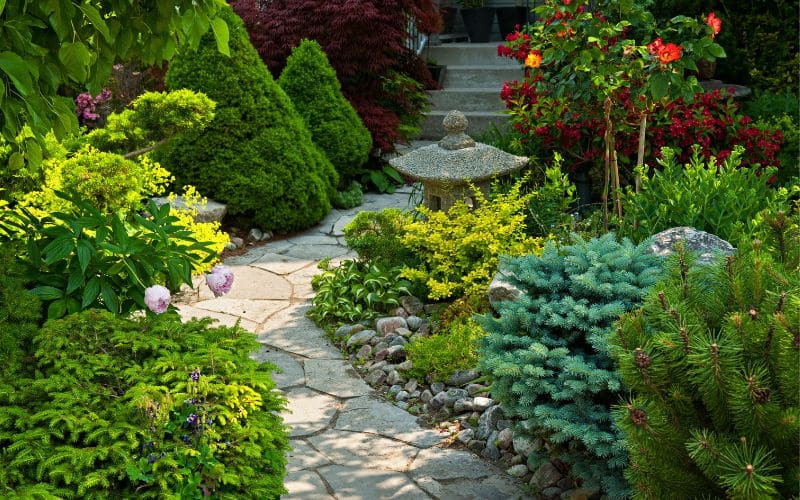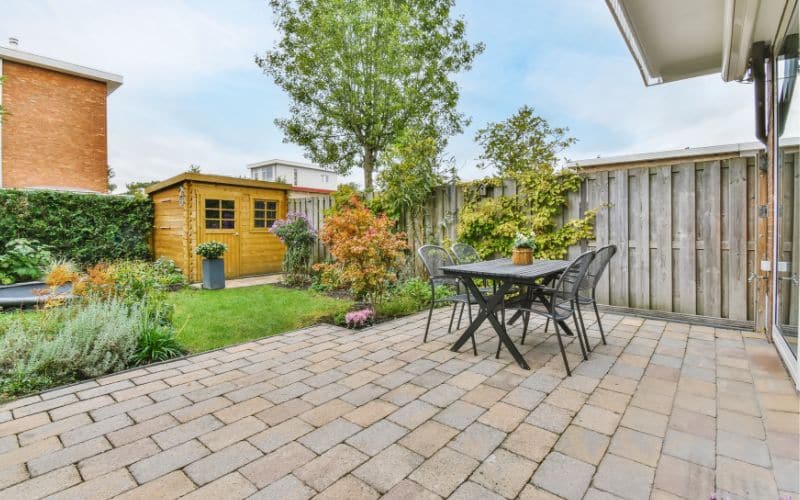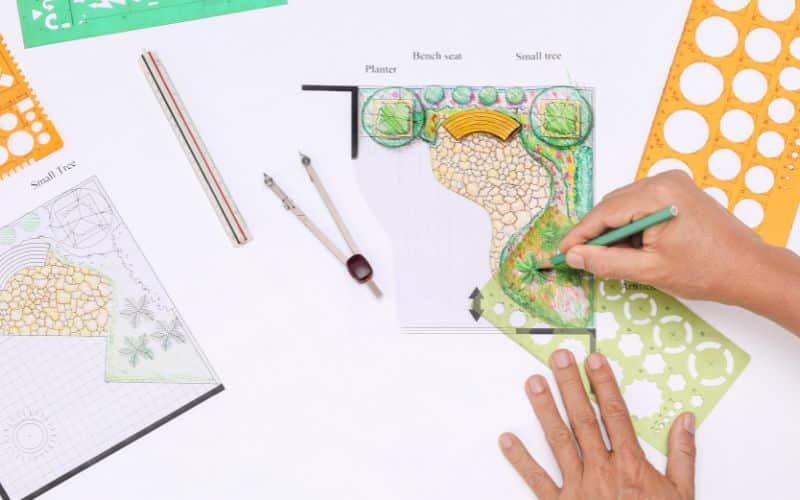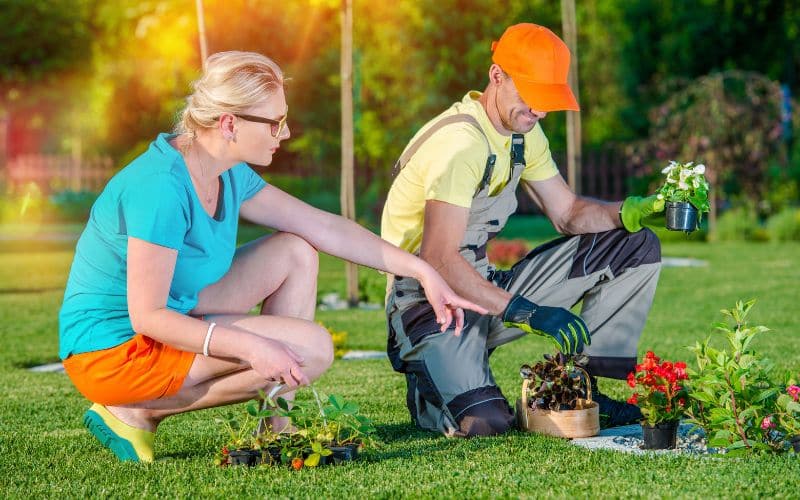
What is Landscaping?
Landscaping is the delightful blend of art and science that melds the beauty of nature with human ingenuity to design outdoor spaces. Let’s journey through the wonders of landscaping as it harmoniously fuses nature and design to create stunning, functional environments.
The Key Elements of Landscaping

Hardscape Elements
Hardscape elements refer to the non-living, structural components that are designed and built within a landscape. They play a crucial role in defining space, providing functionality, and enhancing overall aesthetics. Some key hardscape elements include:
Pathways: Incorporating practical pathways, such as patios, walkways, and driveways, is essential in shaping the layout of a landscape. These pathways allow for easy navigation and improve accessibility in and around the landscape area.
Retaining walls and fences: Retaining walls and fences serve multiple purposes in landscaping, such as providing privacy, enhancing security, and creating vertical support for plant life. These structures can be built using various materials like wood, stone, or metal, and help to delineate boundaries or create separate sections within an outdoor space.
Water features: Adding water elements like fountains, ponds, or streams can significantly elevate the ambiance of a landscape. Water features contribute to the overall aesthetics by blending elegance and tranquility in the space. They can also introduce calming sounds, create a pleasing visual focal point, or become a habitat for local flora and fauna, thus enriching the ecosystem.
Softscape Elements
Softscape elements comprise the living components within a landscape, such as plants, trees, and flowers. They are vital for infusing natural beauty, enhancing the environmental value, and creating a sense of harmony in an outdoor space. Some key softscape elements include:
Plants, trees, and flowers: These living elements contribute significantly to a landscape’s overall aesthetics and environmental worth. They add color, texture, and visual interest while offering shade, purifying the air, and providing habitats for wildlife. Selecting appropriate plants, trees, and flowers based on the local climate, soil type, and intended design ensures a thriving, cohesive landscape.
Soil and mulch management: Maintaining the right balance of soil and mulch is crucial for healthy plant growth and ecosystem development. Good-quality soil provides essential nutrients, while mulch serves as a protective layer that helps retain moisture, regulate soil temperature, and prevent weed growth.
Lawns and ground covers: Incorporating lawns and ground covers creates a lush, green canvas that connects different landscape elements and defines the outdoor space. Lawns provide a versatile, playable surface, while ground covers, such as low-growing plants or creeping vines, can reduce soil erosion and suppress weed growth.
The Core Design Principles of Landscaping

Unity and harmony
Unity and harmony refer to the overall cohesion and consistency present in the landscape design. This principle aims to create a sense of interconnectedness among diverse elements, including hardscape and softscape components.
Scale and proportion
Scale and proportion involve ensuring that the various landscape elements maintain proper relationships in terms of size, dimensions, and arrangements. This principle is essential for establishing a sense of order and organization in the landscape.
Balance and symmetry
Balance and symmetry create a visually pleasing, stable composition in the landscape. This can be attained through symmetrical arrangements, which mirror one side of the landscape with the other, or asymmetrical balance, which establishes equilibrium by using contrasting elements in a harmonious way.
Color and texture
Incorporating a diverse range of colors and textures gives a landscape a multi-layered, vibrant appearance. This principle involves selecting plants, hardscape materials, and decorative elements with contrasting colors and textures, which adds depth and visual interest to the design.
Focal points and emphasis
Focal points and emphasis involve drawing the viewer’s attention to specific areas, features, or elements within the landscape, such as a water feature, sculpture, or an impressive tree. Designers can create focal points by using contrasting color schemes, unique elements, or architectural structures that stand out from the rest of the design.
Rhythm and movement
Rhythm and movement are principles that dictate how the eye travels around the landscape as one takes in the scenery. By incorporating repeating patterns, lines, or shapes, designers can establish a sense of rhythm that guides the viewer’s eye through different areas of the landscape.
Landscaping for Various Purposes

Crafting recreational and relaxation spaces
Designing outdoor spaces for recreation and relaxation caters specifically to unwinding and enjoying the surrounding environment. These areas may feature elements like swimming pools, lounge areas, hammocks, or fire pits to encourage outdoor leisure activities and relaxation. Ensuring adequate shade, ample seating, and privacy can enhance the comfort and usability of these spaces.
Designing areas for entertaining and dining
Outdoor entertaining and dining areas serve as social gathering spaces where people can enjoy meals and engage in conversations. These spaces might include patios, decks, pergolas, or gazebos, furnished with comfortable seating, an outdoor kitchen, or a barbecue grill. Proper lighting, ample circulation space, and thoughtful arrangements create an inviting atmosphere that fosters gatherings in the open air.
Emphasizing environmental benefits
Focusing on sustainable landscaping practices and eco-friendly materials can greatly reduce the adverse environmental impacts of landscaping projects. Some strategies for creating environmentally responsible landscapes include using native plants, promoting biodiversity, incorporating permeable hardscape materials, practicing efficient irrigation, and reducing lawn space.
Enhancing aesthetic appeal and property value
A visually pleasing landscape not only increases the enjoyment of the outdoor space, it also positively impacts the property value. To create an aesthetically appealing landscape, designers utilize diverse plantings, artistic hardscape features, and striking visual elements. A well-designed landscape can transform a property’s exterior, boost curb appeal, and ultimately contribute to a higher overall property value.
Landscaping Journey

Assessing the site
The first step in the landscaping process is the assessment of the site. This involves evaluating factors such as topography, sun exposure, shade, and drainage, which influence the overall design and plant choices. A thorough site analysis helps identify strengths, weaknesses, and unique characteristics of the landscape, which can be used to create a tailored design for the specific location.
Creating a design plan
After assessing the site, the next step is to develop a design plan that visualizes the arrangement of the landscape features. This can involve sketching layouts, creating mood boards, or using computer-aided design software to generate digital plans. The design plan should include hardscape elements, softscape components, and other desired features, as well as take into account the site conditions identified during the initial assessment.
Selecting materials, plants, and features
Choosing appropriate materials, plants, and features is crucial for creating a landscape that is compatible with the climate and aligns with the design vision. This stage requires research on suitable plant species, materials that match the style and intended durability, and features that fulfill the desired functionality.
Implementing and installing
Once the design plan is completed and the necessary materials, plants, and features are selected, the next step is to implement and install the landscape. This process may involve site preparation, earthworks, hardscape construction, softscape installation, and irrigation setup.
Maintenance and care
An essential aspect of the landscaping journey is the continued maintenance and care of the landscape to preserve its beauty, functionality, and health. Regular maintenance tasks include pruning, weeding, pest management, fertilization, and irrigation management.
Hiring a Pro vs. DIY Landscaping

Identifying when to use a professional landscaper
Determining when to hire a professional landscaper depends on various factors, such as the complexity of the project, the scope of work, and your personal skills and knowledge in landscaping.
Benefits of a professional touch
Hiring a professional landscaper offers several advantages, including:
- Design expertise
- Horticultural knowledge
- Technical know-how
- Time and labor savings
- Potential cost savings
Conclusion
Landscaping holds the key to transforming outdoor spaces into beautiful, practical, and functional environments that enrich our lives. By emphasizing core design principles, incorporating diverse hardscape and softscape elements, and tailoring landscapes for various purposes, stunning outdoor spaces can be brought to life.
Whether created by enthusiastic homeowners or seasoned landscape professionals, a well-designed landscape can offer numerous benefits, such as enhancing aesthetics, increasing property value, and promoting sustainable practices.
It is crucial to carefully evaluate your skills, resources, and project complexity before deciding whether to hire a professional landscaper or opt for a DIY approach. Both paths can lead to impressive outcomes, but they differ in the level of expertise, time investment, and potential costs involved.
Landscaping FAQs:

What’s the difference between hardscape and softscape?
Hardscape involves non-living elements like patios, walkways, and walls, while softscape features living components like plants and trees.
How do I start designing my landscape?
Start with a site assessment, outline your needs, and sketch a rough design. Consider a professional consultation if you need help.
What plants are best for my area?
Reach out to local gardening centers or extension offices for information on suitable native plants or those fitting your region’s climate.
How crucial is maintenance in landscaping?
Proper maintenance is essential for preserving a healthy, attractive, and functional landscape year-round.
How can I make my landscape environmentally friendly?
Utilize native plants, limit lawn space, use efficient irrigation, and prioritize sustainable hardscape materials.
Colin Macmillan is a seasoned entrepreneur and the CEO of Riverwood Landscape, a leading landscaping company based in Canada. He has been at the helm of the company since leaving high school, demonstrating his strong leadership skills and business acumen.
Colin’s expertise lies in various aspects of landscaping, including lawn care, interlocking, sod installation, and commercial maintenance. His hands-on approach and dedication to the craft have been instrumental in building Riverwood Landscape into a reputable brand.
One of his most notable achievements is the creation of a successful landscape franchise that services multiple locations. This accomplishment underscores his strategic thinking and ability to scale operations effectively.
Colin has also had the privilege of working with Guelph Hospital for landscaping and maintenance, a testament to the trust and reliability that his company has earned over the years.
His professional mission is to offer the best services and experiences for customers, a goal that he tirelessly pursues. Colin’s commitment to excellence and customer satisfaction continues to drive the growth and success of Riverwood Landscape.








